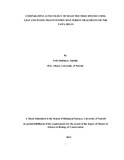| dc.description.abstract | This study was aimed at associating the autecology of selected tree species in nine indigenous fragments of the Taita Hills forests, using their leaf and wood traits. Tree species (0.5 to 3.5) m, were selected due to their dominance and abundance in the forest. Understanding autecology of a forest would impact essential knowledge on what conservation measures to undertake e.g. when reclaiming such a habitat by a forestation or when managing forest gaps that may result in large scale fragmentation and eventual degradation of a habitat. Recently leaf and wood traits have proven to be effective in determining plant autecology from previous studies done. Random collection of 10 leaf samples from each tree specimen for farther analysis was done. A total of 3000 leaf samples were collected. Position, altitude and light class was determined for each plant sampled using a GPS and an improvised densiometer. Leaf fresh and dry mass was obtained by weighing the leaves on a balance. Leaf petiole length was also measured using a vernier caliper while thickness was determined using a micrometer screw gauge. Leaf dry mass content was determined (by dividing the leaf dry weight and wet weight then multiplying this by 100%). Foliar N and P were determined using wet Kjedhal method and Spectral analysis. Wood density for samples collected was determined using the volume displacement method. Average values for variables were correlated and compared using multiple correlation, ordination (PCA) and cluster analysis. Correlation coefficients (r & rho) for species together with correlations for the PCA and axis which they lay on identified the following species in respective functional groups:- Maesa lanceolata, Tabernaemontana stapfiana and Milletia oblata as edge species, Macaranga capensis, Newtonia buchananii, Polyscias fulva and Prunus africana as Pioneer/light species, Phoenix reclinata, Rapanea melanophloes, Syzigium guinensee and schlerophyllum as adaptive species able to adapt to changing conditions depending on the canopy cover. Chrysophyllum gorungosanm, Craibia zimmermanii, Leptonychia usambarensis and Strombosia scheffleri classified as shade species. A cluster analysis done for fragments had a dendogram with two major clusters at 82% similarity; Vuria – Iyale fragments were on one side while the other fragments on another. Notably, all fragments had over 80% similarity. The cluster for species had Phoenix reclinata and other species at 69% similarity, while other species were differentially similar. The PCA established that fragments in the same locality and with similar species were grouped together. It was concluded that for majority of the species, leaf and wood traits were indeed associated with altitude and light class for the species studies in the various fragments of the Taita hills forests. Altitude and canopy cover played a major role in defining the survival of these species. | en_US |

